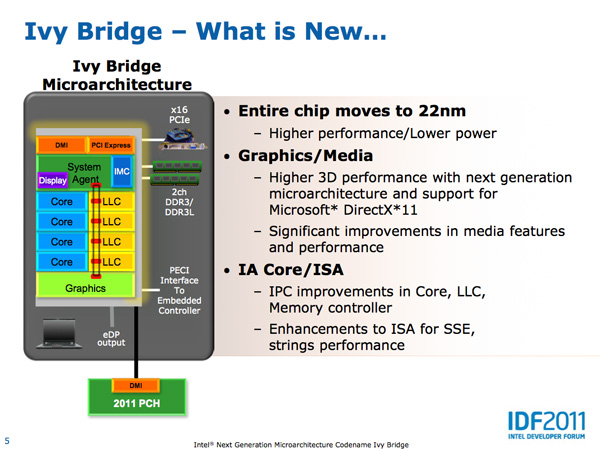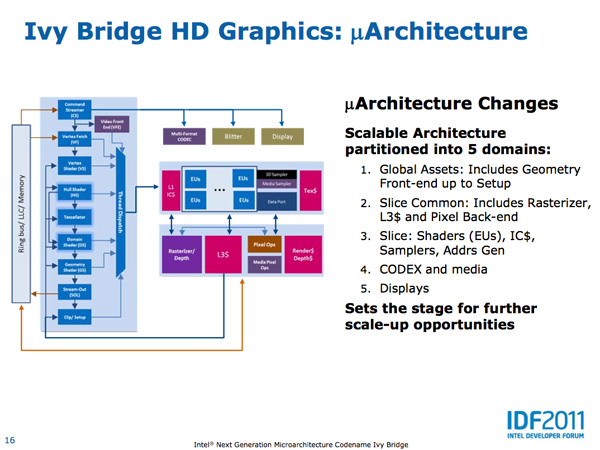The Ivy Bridge Preview: Core i7 3770K Tested
by Anand Lal Shimpi on March 6, 2012 8:16 PM EST- Posted in
- CPUs
- Intel
- Core i7
- Ivy Bridge
Ivy Bridge Architecture Recap
At IDF Intel disclosed much of Ivy's CPU architecture, but below is a quick summary:
- 4-wide front end with µOp cache from Sandy Bridge
- OoO execution engine from Sandy Bridge
- Data structures previously statically shared between threads can now be dynamically shared (e.g. DSB queue), improves single threaded performance
- FP/integer divider delivers 2x throughput compared to Sandy Bridge
- MOV instructions no longer occupy an execution port, potential for improved ILP when MOVs are present
- Power gated DDR3 interface
- DDR3L support
- Max supported DDR3 frequency is now 2800MHz (up from 2133MHz), memory speed can be moved in 200MHz increments
- Lower system agent voltage options, lower voltages at intermediate turbo frequencies, power aware interrupt routing
- Power efficiency improvements related to 22nm
- Configurable TDP
I've highlighted the three big items from a CPU performance standpoint. Much of the gains you'll see will come from those areas coupled with more aggressive turbo frequencies.


On the GPU, the improvements are more significant. Some of the major changes are below:
- DirectX 11 Support
- More execution units (16 vs 12) for GT2 graphics (Intel HD 4000)
- 2x MADs per clock
- EUs can now co-issue more operations
- GPU specific on-die L3 cache
- Faster QuickSync performance
- Lower power consumption due to 22nm






















195 Comments
View All Comments
Zoomer - Wednesday, March 7, 2012 - link
It would have been interesting to see. Personally, I don't care for IGP, as they sit disabled anyway. Right now, it seems like it's a 7% clock for clock perf increase, which is very poor for one process node. Knowing where the clocks can be will let everyone know exactly how much faster the CPU can be over SB.NeBlackCat - Wednesday, March 7, 2012 - link
For me, the most interesting things about IVB are improved multi-monitor support, and power savings not just at stock, but also undervolted (stock clock) and overclocked.Because I want to know if I'm finally going to get that laptop or mini-itx system that can drive several monitors while remaining cool and sipping power, even under load.
Not covered at all. Shame.
beck2050 - Wednesday, March 7, 2012 - link
Intel marches on. Their domination of 80+% of all CPU markets will continue.silverblue - Wednesday, March 7, 2012 - link
PC and especially server market, sure, but not smartphone/tablet. Not yet, anyway.fvbounty - Wednesday, March 7, 2012 - link
Should have a had SB 2700K to run clock for clock against the 3770K and see if there's much difference!ellarpc - Wednesday, March 7, 2012 - link
Agreed! I was just about to post that same comment. It doesn't make much sense to compare it to a lower clocked SB product. Well unless you wanted to make the IB look better. Now I'm going to sift through anand's past reviews to see what kind of gains the 2700 has over the 2600.ellarpc - Wednesday, March 7, 2012 - link
Doesn't look like Anand has a 2700k for testingueharaf - Wednesday, March 7, 2012 - link
I was thinking that the difference in gpu perfomance between HD3000 and HD4000 about 20% to 40% increase perfomance, will remain in the ivy-bridge mobile chips!!! I hope soo!!!lilmoe - Wednesday, March 7, 2012 - link
Great review. You guys know your stuff. I've been waiting for a review like this since IvyBridge was announced.However, I'll still "cling to my Core 2" since it does the job now, and I'll postpone my upgrade till next year. You make it seem like Haswell is a good reason to wait. I bought the system in early 2010, and I usually upgrade every 2-4 years. 3 years sounds just right. I'll be investing in SSDs since you talked me into it though, it seems a better upgrade at the moment.
Breach1337 - Wednesday, March 7, 2012 - link
Did Intel specifically ask not to include overclocking tests in ES previews?